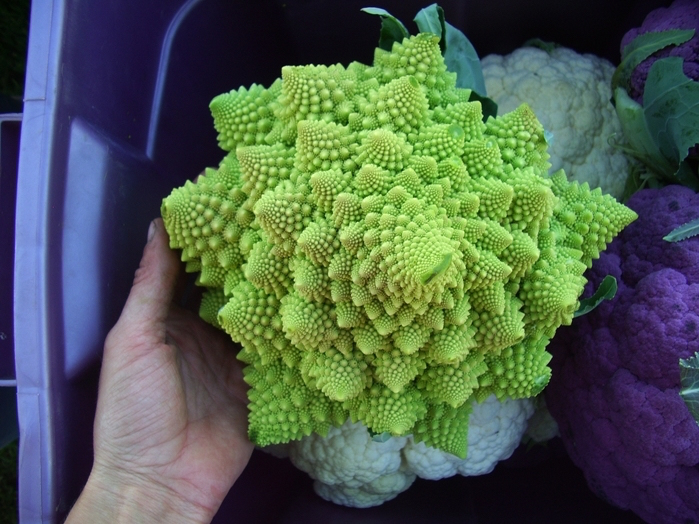First it was kale cupcakes, kale calzones and kale chips. That was then. Now it’s cauliflower pasta, cauliflower steaks and cauliflower pizza.

There are many varieties of cauliflower – many of which grow well in Alaska. This is a Romanesco Cauliflower.
Why the cauliflower craze? When compared with kale, although not quite as nutritious, cauliflower is less overpowering both in taste and in texture. If you’ve ever added a cup of kale to make your smoothie just a little bit healthier, then you know what I mean. With a little help from a good blender or food processor, you can make cauliflower into a silky smooth, ricelike or a hearty texture, depending on what your dish requires.
The rise of cauliflower is also no doubt due to ubiquity of carb-limiting or eliminating diets. Cauliflower is bland and white — kind of like mashed potatoes, pancakes, biscuits, rice, pasta and pizza dough—all big no-nos in many diets today. Google to find the type of recipe you want. For example, search for “cauliflower rice.” My favorite ways to use cauliflower are cauliflower biscuits, creamed cauliflower cashew soup and birbal kee khitcheree, which is a fantastic Indian dish that unites one of my other favorite ingredients, lentils.
Another nice thing about cauliflower? You can fill up while limiting your calories and maximizing your nutrients. According to the U.S. Department of Agriculture, a big head of cauliflower is about 200 calories and contains 16 grams of protein and fiber. Notably, cauliflower is very high in potassium and also a great source of vitamin C (nearly as much as an orange) and folate.
Cauliflower and other brassicas—such as broccoli, cabbage, kale and Brussels sprouts—grow well in Interior Alaska where the weather is cool and the pests are scarce. Another reason to grow cauliflower? Because of the spike in demand, there have been reports of cauliflower selling for as much as $8 per head.
If you want to grow cauliflower, start your own seeds as early as April 15 or purchase transplants. Directly seeding cauliflower in your garden is not recommended due to our short summers. To maintain a steady supply of cauliflower throughout the summer, start cauliflower varieties that differ in how many days they take to reach maturity. For instance, Snow Crown matures in 50 days, Amazing in 68 days, Denali in 73 days, and Skywalker in 80 days. If you start seeds of these four varieties on the same day, you will have a nice, staggered harvest. Alternatively, you could start seeds of the same variety every couple of weeks until mid to late June, depending on which variety you plant. University of Alaska Fairbanks Cooperative Extension recommends the following varieties for Interior Alaska: Amazing, Fremont, Minuteman, Snow Crown and White Sails, but most cauliflower varieties will thrive in Fairbanks.
For information on growing cauliflower and other brassicas in Alaska, see the UAF Extension publication to find more in-depth advice on soil type, fertilizer recommendations, dealing with pests, as well as recommended varieties and even a few recipes.
Now, with a little imagination, you’ll be able to enjoy your favorite foods guilt-free!
Previously published in the Fairbanks Daily Newsminer June 5, 2016.
